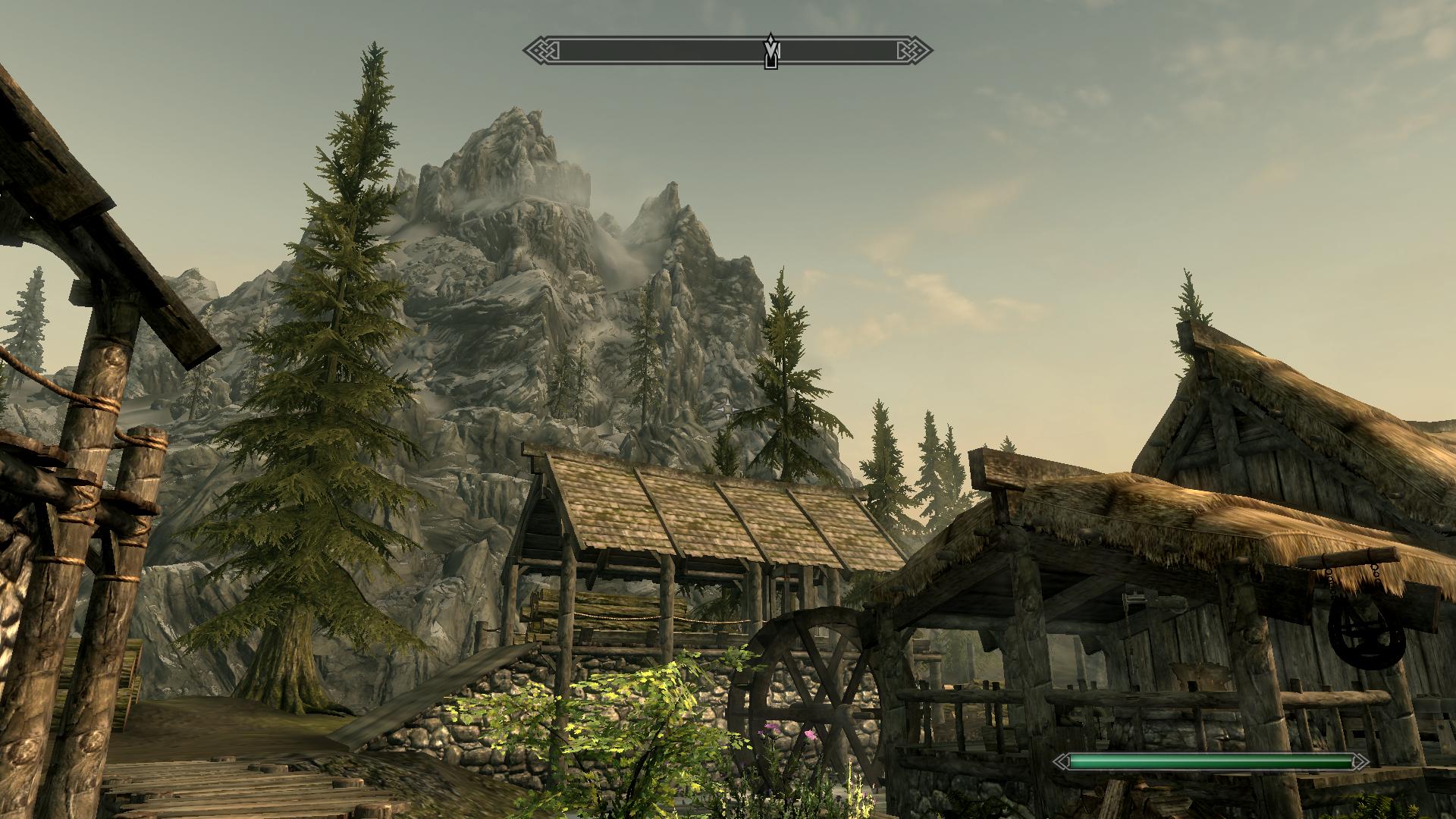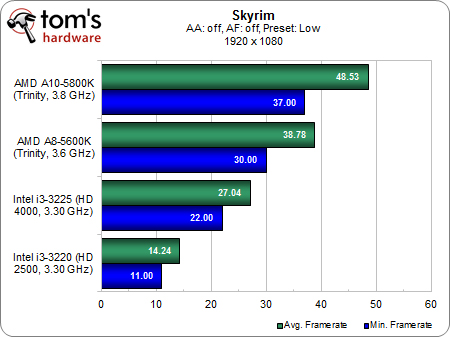Gaming At 1920x1080: AMD's Trinity Takes On Intel HD Graphics
Think you're pretty snazzy because your integrated graphics core plays mainstream games at 1280x720? We're on to bigger and better things, like modern titles at 1920x1080. Can AMD's Trinity architecture push high-enough frame rates to make this possible?
Benchmark Results: Skyrim And Deus Ex: HR
The Elder Scrolls V: Skyrim employs DX 11 support to enhance performance. The Creation Engine used by Bethseda is the same one used for Elder Scrolls IV: Oblivion, and there’s been little to no visual improvement between generations. However, the faster implementation pays dividends for our purposes.
In AMD Desktop Trinity Update: Now With Core i3 And A8-3870K, we benchmarked with The Elder Scrolls V: Skyrim and discovered that the Medium quality preset simply was not playable on any of the processors we tested at 1920x1080 (the A10 and A8 were arguably pretty fluid at 1280x720, though).
Dropping quality all the way to the Low preset does give AMD's new APUs a lot more room to breathe at our target resolution. It's just a bummer that the graphics quality is so terrible down there. Our benchmarks suggest this game is accessible to Trinity, but we'd strongly suggest an upgrade to discrete graphics and a step up to at least the Medium quality preset.
Intel's Core i3s, on the other hand, cannot muster playable performance, even at this game's most entry-level settings.
As we’ve described in the past, Deus Ex: Human Revolution excels in two key points: amazing story quality and excellent use of anti-aliasing modes made available through DX 11. Fortunately, Eidos Montreal made sure the game was GPU-friendly, even without DX 11 assistance. Our earlier testing with discrete graphics showed that Human Revolution is playable at 1920x1080 with medium details and 8x AF enabled across a broad spectrum of last year's graphics cards. So, it comes as no surprise that three of our four integrated engines turn in average frame rates in excess of 30.
The AMD A10-5800K averages close to 50 FPS, and its minimum dips to 37 FPS. That might leave a little bit of headroom for more demanding settings, but we wouldn't push this title much further. Intel’s Core i3-3225 is barely able to deliver an average in excess of 30 FPS, but its 23-frame minimum is a little low for our liking. You can expect frequent stutters, even with all detail settings as low as they go.
Get Tom's Hardware's best news and in-depth reviews, straight to your inbox.
Current page: Benchmark Results: Skyrim And Deus Ex: HR
Prev Page Benchmark Results: Call Of Duty: MW3 And Metro 2033 Next Page Benchmark Results: Battlefield 3, Crysis 2, And Witcher 2-
azathoth Seems like a perfect combination for a Casual PC gamer, I'm just curious as to the price of the Trinity APU's.Reply -
luciferano They both have graphics that have HD in their name, but AMD's HD graphics are more *HD*, lol.Reply -
Nintendo Maniac 64 Err... did we really need both the A10-5800k and the A8-5600k? Seeing how both are already 100w unlocked CPUs, surely something like an A10-5800k vs a 65w A10-5700 would have been more interesting for an HTPC environment...Reply -
mayankleoboy1 Consoles set the bar for game developers. These iGPU's are comparable to the consoles and thats why games will run smooth here.Reply
With next gen consoles coming out next year, game devs will target them. Hence the minimum standard for games will rise, making the next gen games much slower on the iGPU's. So both AMD and Intel will have to increase performance much more in the next 1-2 years.
tl;dr : next gen games will run poorly on these igpu's as next gen consoles will set the minimum performance standard. -
mousseng Reply
Keep in mind, though, that that's exactly what's going to allow AMD and Intel to advance their hardware faster than games will, as they were discussing in the article (first page of the interview). Look how far Fusion and HD Graphics have come over the past 3 years, and look how long the previous console generation lasted - if that trend is anything to go by, I'm sure integrated graphics could easily become a viable budget gaming option in the next few years.9537609 said:tl;dr : next gen games will run poorly on these igpu's as next gen consoles will set the minimum performance standard. -
falchard Since when as AMD or nVidia actually taken on Intel graphics? Thats a bit insulting considering the disproportionate results time and time again.Reply -
luciferano mayankleoboy1Consoles set the bar for game developers. These iGPU's are comparable to the consoles and thats why games will run smooth here.With next gen consoles coming out next year, game devs will target them. Hence the minimum standard for games will rise, making the next gen games much slower on the iGPU's. So both AMD and Intel will have to increase performance much more in the next 1-2 years.tl;dr : next gen games will run poorly on these igpu's as next gen consoles will set the minimum performance standard.Reply
Actually, the A10 and A8 have somewhat superior graphics compared to current consoles. Current consoles can't even play in 720p as well as these AMD IGPs played 1080p despite being a more optimized platform, so that this is true is kinda obvious IMO. Also, new games would simply mean dropping resolution for these APUs. They wouldn't be unable to play new games, just probably at 1080p and 16xx by 900/10xx resolutions too.
Intel probably isn't very motivated by gaming performance for their IGPs and they're supposedly making roughly 100% performance gains per generation with their top-end IGPs anyway, so they're working on growing IGP performance. AMD also gets to use GCN in their next APU and I don't think that I need to explain the implications there, especially if they go the extra mile with using their high-density library tech too.



